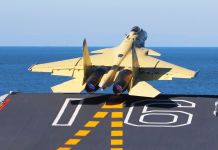Chinese President Xi Jinping’s ambitious plan for the People’s Liberation Army to achieve the “world-class” status through rapid military modernization has become an increasing threat for the US.
A 2019 Defense Intelligence Agency (DIA) report talked in detail about China’s military modernization plans and its current strengths. It also pointed towards Beijing’s plan to develop a “next-generation tactical bomber” but didn’t mention its name or any details about it.
Citing a Chinese magazine “Aerospace Knowledge,” The National Interest reported that the magazine cover featured a JH-XX concept. “The JH-XX features a more traditional airframe layout that shares more in common with the likes of China’s J-31,” it noted.
https://youtu.be/tvpcLKiw_0E
“The concept shows canted tail stabilizers, two prominently placed turbofan engines, and a sizable internal weapons bay. The JH-XX may feature an active electronically scanned array (AESA) radar, but little is known of its avionics package beyond that.
The fighter will reportedly have a combat radius of roughly 3,000 kilometers and be capable of supersonic flight.”
On the other hand, the Xian H-20, a strategic project of the PLA as the first dedicated strategic bomber developed by China was first announced in 2016 by the People’s Liberation Army and is seen as a counterweight to possible US militarization of the region which includes providing stealth F-35 jets to neighboring countries, reported the SCMP.
It is expected to travel long distances and will likely have a range of “at least 8,500 km” and “employ both conventional and nuclear weaponry,” according to the 2018 China Military Power Report to the US Department of Defense.
While there’s very little public information available about the JH-XX, it is expected to be used for regional adversaries around the Chinese territory including in the East and South China sea.
According to The National Interest, based on JH-XX’s purported design and the details offered by the DIA report, the JH-XX seems to trade the H-20’s range and payload capacity for faster speed and enhanced dogfighting potential.

The H-20 is expected to give a tough competition to the American B-21 Raider. Northrop Grumman is currently building the first test aircraft in Palmdale, California and the Air Force looks forward to procuring at least 100 B-21 Raider bombers.
The B-21, which will be in service in the next two years, will serve as an advanced very long-range, large, heavy-payload stealth intercontinental strategic bomber and bring in new dimensions of stealth, software, offensive possibilities, and nuclear deterrence to the US Air Force.
“The B-21 is intended to stand in and hit heavily defended targets with special-purpose weapons that we can use to strike from a distance or by other means. We know the B-21 will bring unique characteristics with low observability and weapons,” said General Mark E. Weatherington, Commander, Eighth Air Force, and Commander, Joint-Global Strike Operations Center, while speaking with The Mitchell Institute for Aerospace Studies.
The tailless, bat-like B-21 Raider bomber is the futuristic take on its predecessor the B-2 Spirit Bomber, despite having the same physical features. The bomber is expected to be integrated with both nuclear and conventional weapons and could be equipped with the Advanced Applications Rotary Launcher (AARL) used by the B-2 bomber, to make use of one bomb bay, enabling it to carry eight bombs or missiles.




